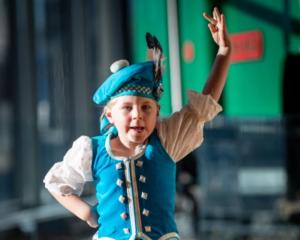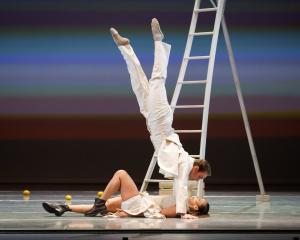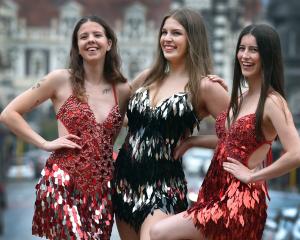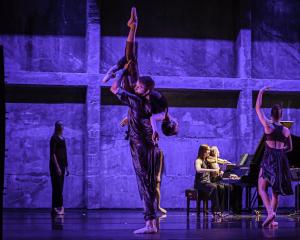
Loughlan PRIOR never thought he would use a ‘‘jazz hand’’ in his choreography but his version of Hansel and Gretel called for it — as well as the Cancan, a touch of drag and a mash up of cabaret performer and Kylie Minogue showgirl.
Not the average Royal New Zealand Ballet production then.
Prior, choreographer in residence at RNZB, says he was not trying to ‘‘break any moulds’’ in his first full-length production for the RNZB.
But composer Claire Cowan — who is the first woman to compose a full-length score for a RNZB ballet — disagrees.
‘‘It is innovative.’’

The pair have known each other for years and have worked on a couple of projects in that time.
So when Prior, who retired as a dancer just a few months ago, was offered the opportunity by RNZB to create a ballet, he immediately thought of Cowan.
‘‘I said Hansel and Gretel would be amazing and we’d need a new score — Claire’s the one for that as she’s awesome.’’
He chose Hansel and Gretel as it did not appear often in classical ballet, because it was more of a opera production.
‘‘It’s such a fantastic story. Everyone knows it, but there is a lot of room for adaptation.’’
What followed was an intense creative week with Prior and Cowan (of the dance group Blackbird Ensemble) throwing around ideas and coming up with concepts.
Both were finding their way. It was the first time Prior had worked so closely with a composer while it was Cowan’s first ballet score to write.
‘‘I’ve always really wanted to write a ballet.’’
Prior says the experience was incredible, and that Cowan did an excellent job of translating their ideas into the score.
‘‘When I hear what Claire has created down to the bar I can hear all the discussions we had about the actions in the story and what we want the audience to feel and what the characters are trying to say.
‘‘It’s so incredibly clear because we got to work together so closely at the beginning of the project. We fed off each other.’’
They went on to collaborate through videos and conversations from afar; Cowan was based in Auckland while Prior worked with the dancers in Wellington.
When Hawley joined the team, she helped to give direction to Cowan and Prior’s more imaginative concepts for the fairytale.
The pair had been throwing around lots of ideas for the setting of the ballet, from the 1980s to the 1950s and even the 18th century.
‘‘We had like 12 scenes to begin with — we were thinking of making a movie rather than a ballet, so she reined us in,’’ Cowan says.
It was with Hawley’s input that they came up with the idea to set the ballet in the 1920s silent film era. The flickering, grainy charm of early films such as Georges Melies’ A Trip to the Moon (1902), where the magic was achieved in monochrome, with ‘‘projections and animations adding mystery and sometimes, menace’’ were inspiring to the team, Hawley says.
‘‘It’s really given the whole story a twist. Rather than doing a literal leafy green forest, we have a forest of forks that literally grow out of the ground,’’ Prior says.
‘‘It’s really cool to hark back to that German expressionist sensibility that is in those early films — also the language of classical ballet fits really well with the silent film treatment.’’
The costumes are also suggestive of that time period with tailoring, top hats and fox furs for the ‘‘haves’’ versus the much patched, shabby garments of the ‘‘have-nots’’, Hansel and Gretel.
Cowan’s score reflects that sensibility — one of her favourite musical moments is when the mother and father lose hope of finding their children — but also swings wildly with the mood of the ballet. Influences from musicals, burlesque, cabaret and drag shape this rollercoaster.
‘‘A lot of the second half is jazz and broadway, an over the top grotesque use of broadway style that is reciprocated in the dance — it’s so fabulous and camp, almost cringeworthy at times,’’ Prior says.
Cowan says the team decided to added a baritone and tenor saxophone player to add a jazz flavour to the orchestra’s woodwind section, and a harpsichord and organ alongside the celeste, while the percussion section included pots and pans and musical bones.
‘‘The finger cymbals are a feature of the entire ballet. They represent an element of magic and they’re one of my favourite sounds in the orchestra.’’
Prior always tries to ensure his work looks like it is ‘‘seamlessly custom-made’’ for the music, as it brings the performance of the score to life.
‘‘I never thought I’d use a jazz hand in my choreography but it lends itself so well to the thematic content.’’
For Cowan this is a first.
‘‘I’ve never had a dancer do that for my work before.’’
Prior says they went out of their way to include popular culture references throughout the production.
‘‘What I like is that you get a show that is very familiar — you recognise things when they pop up but they are fused in such a way it feels like a totally new product.’’
The witch’s ‘‘steam-punk’’ bicycle theme music evokes a cross between Mr Whippy and old German organ grinders.
The story is also carried through in the colour scheme the trio developed. Hansel and Gretel’s tale is told in chiaroscuro: a dark and moody first half, punctuated by the deep red of the witch as she entices the children with her brightly decorated ice creams, contrasts sharply with the light, bright, candy pinks of the second half.
‘‘I love stories that have light and dark elements. We could have played the witch really dark but instead she’s this Kylie Minogue hostess type character that snacks on children,’’ Prior says.
Given the production is a ‘‘first’’ for both of them there were understandably some nerves leading up to opening night.
‘‘I think I’m a lot more nervous in a creative capacity [than dancing] — you’re more vulnerable as it’s my brain on stage. I completely trust the performers and crew but you still get that kind of ...’’
Cowan agrees they are putting themselves on the line with this production.
‘‘It’s quite a brave thing to do to be creative, to have people watch your work and judge it.’’
Despite this, it is has been an opportunity of a lifetime for Cowan who has decided she would much rather write a ballet than a symphony.
‘‘I’m so much better doing soundtracks, if I’ve got a story to write to. And it’s gratifying to see your work come to life in a visual sense.’’
For Prior it cements his move into choreography.
‘‘I feel pretty good with this new career path.’’
Both hope to work together again.
‘‘I’d be heartbroken if this is the last ballet we do,’’ Cowan says.
HANSEL AND GRETEL
Written by the Brothers Grimm — Jacob and Wilhelm
- Is about two hungry children lured by away by a witch promising food
- Appeared in their first volume of tales published in 1812
- The brothers made substantial changes to the original version
- Inspired the opera Hansel und Gretel, by Humperdinck, which premiered in 1893
- Has themes of poverty, greed, bullying, stranger danger and adversity
TO SEE
Hansel and Gretel, Royal New Zealand Ballet, Invercargill, Civic Theatre, tonight, 7.30; Dunedin, Regent Theatre Saturday, 7.30pm.












